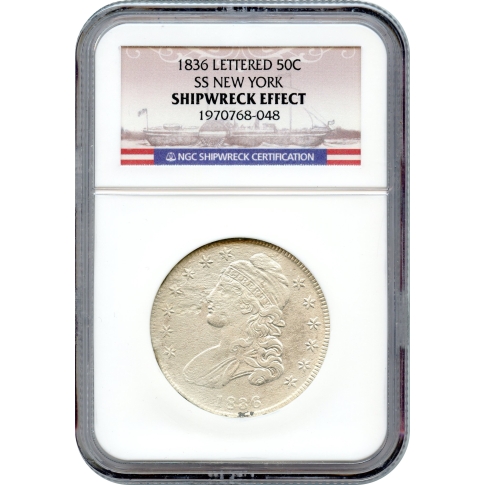1836 50C Capped Bust Half Dollar, Lettered Edge NGC SE Ex.SS New York
Here’s an unusual artifact to include in your numismatic collection: a shipwrecked Capped Bust half dollar from 1836. Plus it is much more affordable than a gold piece. Over the years, most retrieved shipwrecked coins have been gold. Are you fascinated by classic U.S. coinage? And shipwreck lore? Then please take a close look at the images provided by AUCM of this artifact from the wreckage of the SS New York. Perhaps it should be the newest addition to your collection.
Newspaper ad for the steamboat New York. From the Telegraph and Texas Register, March 2, 1842. Photo: Wikimedia Commons.
The SS New York conducted a light cargo and passenger service between New Orleans and Galveston. It included military and post office contract passage until it submerged on September 7, 1846, during a hurricane. Seventeen of the 53 crew and passengers were lost at sea, along with "thirty to forty thousand dollars in gold, silver, and bank notes," according to reports from contemporary sources.
The ship was first detected in 1990 by an amateur diver and Louisiana oilfield worker. He trusted reports of snags from local shrimp fisherman to locate the wreck. After completion of an archeological survey conducted by the Minerals Management Service, and gaining the legal title to the wreckage, the original explorers returned to recover the ship’s coins in 2006.
The shipwreck of the S.S. New York in 1837, while not as widely publicized or directly impactful on a grand scale compared to other historical events, had several dimensions of significance and consequences:
Historical Context
Economic Climate: The shipwreck occurred during the Panic of 1837, a severe economic depression in the United States. This context is crucial because it frames the incident within a period of financial instability, where losses could exacerbate economic distress.
Immediate Consequences
Loss of Valuable Cargo: The S.S. New York was carrying a significant treasure of gold coins, some of which were among the earliest minted in Southern mints of the U.S. This loss represented not just a financial setback but also a cultural and historical loss, given the rarity and historical value of these coins.
Human Impact: Although specifics on casualties from this shipwreck are not widely detailed, shipwrecks generally result in loss of life or at least significant risk to passengers and crew, affecting families and communities directly involved.
Long-Term Significance
Economic Ripple Effects: While the direct economic impact might not have been catastrophic due to the broader economic turmoil of the time, any loss at this period could amplify the existing financial distress for those involved in the shipping or insurance industries related to the S.S. New York.
Maritime Safety Awareness: Shipwrecks, especially of luxurious or significant vessels, often lead to reviews of maritime safety practices. The S.S. New York's sinking could have contributed to discussions on maritime technology, navigation, and safety regulations, albeit indirectly due to the broader economic concerns overshadowing such incidents.
Treasure Hunting and Historical Interest: The eventual discovery and recovery of the coins from the shipwreck in modern times highlight ongoing interest in historical maritime disasters. This has cultural significance, contributing to numismatics (the study or collection of currency) and maritime archaeology, offering insights into past economic practices and the historical movement of currency.
Reflection on Past Wealth and Commerce: The types of coins and their origins (from Southern mints during early gold rushes) reflect on the economic activity of the time, particularly how gold from different regions was minted into currency. This aspect provides historians with a tangible link to the economic policies, wealth distribution, and trade routes of the 1830s America.
Cultural and Symbolic Impact
Symbol of the Era's Dangers: The shipwreck symbolizes the risks of sea travel and commerce during that period, where luxury and wealth could be quickly lost to natural elements, reflecting the broader theme of boom and bust in 19th-century America.
Legacy in Modern Times: The recovery efforts and the interest in the coins from the S.S. New York serve as a bridge between past and present, engaging modern audiences with the history of American economic development through tangible artifacts.
In summary, while the S.S. New York shipwreck might not have caused a seismic shift in economic or political landscapes directly, its significance lies in its reflection of broader economic themes of the time, contributions to maritime safety awareness, and its legacy in historical and numismatic interests. The event encapsulates the risks and rewards of the maritime trade during a pivotal economic period in U.S. history, offering a microcosm of the challenges faced by the burgeoning nation.
| PCGS # | 6169 |
|---|---|
| Grading Service | NGC |
| Year of Issue | 1836 |
| Grade | XF40 |
| Denom Type | Capped Bust Half Dollar |
| Numeric Denomination | 50C |
| Mint Location | Philadelphia |
| Designation | NONE |
| Circ/UnCirc | Circulated |
| Strike Type | Business |
| Holder Variety | Shipwreck Effect Ex.SS New York |
| Grade Add On | NONE |
| Holder Type | SS New York |




